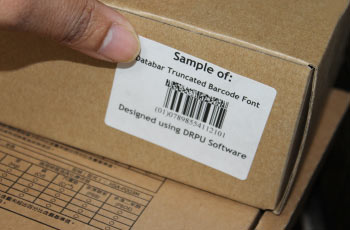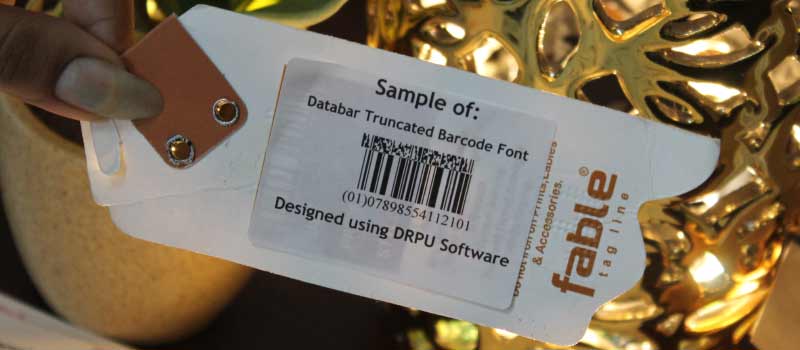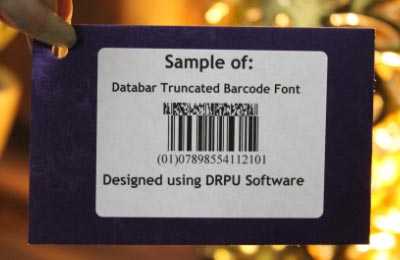Size Of Databar Truncated Barcode
The size of a Databar Truncated Barcode depends on a variety of factors, including the amount of data that needs to be encoded, the printing technology used, and the application requirements. In this answer, we will discuss the size of a Databar Truncated Barcode and the factors that can impact its size.
❖ The Databar Truncated Barcode is a type of linear barcode that is designed to be compact and easy to scan. The barcode consists of a series of vertical bars and spaces of varying widths, with a start character, stop character, and checksum character added for error detection and correction.
❖ The size of a Databar Truncated Barcode is determined by the number of characters that need to be encoded and the printing technology used. Typically, a Databar Truncated Barcode can encode up to 14 characters, including the GTIN and other product information.
❖ In terms of physical size, a Databar Truncated Barcode can range from 0.3 inches (7.6mm) in height for a barcode with a single data character to 1.023 inches (26mm) in height for a barcode with 14 data characters. The width of the barcode can range from 0.5 inches (12.7mm) to 2.835 inches (72mm), depending on the printing technology used.
Several factors can impact the size of a Databar Truncated Barcode, including the following:

A Data Requirements The more data that needs to be encoded, the larger the barcode will need to be. If a product has a long GTIN or additional product information that needs to be encoded, the barcode may need to be larger to accommodate the additional data.
B Printing Technology The printing technology used can also impact the size of the barcode. For example, if a barcode is printed using a low-resolution printer, the bars and spaces may need to be larger to ensure that the barcode can be read by a scanner. On the other hand, a high-resolution printer may be able to produce smaller barcodes with more data.
C Mailer ID : A 6-digit code that identifies the mailer.
D Service Type ID : A 3-digit code that identifies the type of service being used.
E Mailer-Assigned Routing Code : A 9-digit code assigned by the mailer to identify the mail sack.
F Application Requirements : The application requirements can also impact the size of the barcode. For example, if a barcode needs to be printed on a small label, the size of the barcode may need to be smaller to fit on the label. Conversely, if a barcode needs to be printed on a large package, the barcode may need to be larger to ensure that it can be read from a distance.
In summary, the size of a Databar Truncated Barcode can range from 0.3 inches (7.6mm) to 1.023 inches (26mm) in height and 0.5 inches (12.7mm) to 2.835 inches (72mm) in width, depending on the number of characters that need to be encoded, the printing technology used, and the application requirements. By understanding these factors, businesses can choose the appropriate barcode size to meet their needs and ensure that their products can be easily tracked and managed throughout the supply chain.
Purpose Of Using Databar Truncated Barcode
The Databar Truncated Barcode is a two-dimensional (2D) barcode that is used for inventory management and tracking purposes in the retail and healthcare industries. It is a versatile tool that provides a high level of data density, reliability, and flexibility for tracking products and monitoring their movement throughout the supply chain.
In this answer, we will discuss the key purposes of using a Databar Truncated Barcode and the benefits that it provides for businesses and organizations.
-
Accuracy and Efficiency
Finally, Databar Truncated Barcodes provide an efficient and accurate way to track products within the supply chain. The barcode can be quickly and easily scanned using a wide range of barcode scanners, including handheld scanners, stationary scanners, and mobile devices. This allows businesses to quickly and accurately track inventory levels, monitor the movement of products, and identify any issues or discrepancies within the supply chain.
-
Product
Identification:
The primary purpose of a Databar Truncated Barcode is to uniquely identify products within the supply chain. The barcode encodes a GTIN-14 product identifier, which is a 14-digit number that is assigned by the manufacturer and used to track the product throughout the supply chain. This number allows businesses to quickly and easily identify products, track their movement, and monitor inventory levels.
-
Inventory Management
Another important purpose of Databar Truncated Barcodes is to enable efficient inventory management. The barcode can be scanned to quickly and accurately track inventory levels, monitor the movement of products, and identify any discrepancies or shortages in stock. This helps businesses to optimize their inventory levels, reduce waste, and improve the accuracy of their supply chain operations.
-
Expiration Date, Batch
Tracking
Databar Truncated Barcodes also allow for the tracking of expiration dates and lot/batch numbers, which is important for ensuring the quality and safety of products within the supply chain. The barcode can be used to track the expiration date of a product, ensuring that it is sold or used before it becomes expired. Additionally, the barcode can be used to track the lot/batch number of a product.
-
Traceability and Recall
Management
Databar Truncated Barcodes also provide traceability and recall management capabilities, which are critical for ensuring the safety and quality of products within the supply chain. The barcode can be used to track the movement of products from the manufacturer to the end consumer, allowing businesses to quickly identify any issues or defects in the product and take appropriate action. In the event of a recall, businesses can use the barcode to quickly and accurately identify affected products and take action to remove them from the supply chain.
Overall, the purpose of using a Databar Truncated Barcode is to provide businesses with a versatile tool for tracking products within the supply chain. It enables efficient inventory management, traceability and recall management, expiration date and lot/batch tracking, and provides a reliable and accurate method for tracking products throughout the supply chain.
Databar Truncated Barcode Differ From Other Types Of Barcodes
A Databar Truncated Barcode is a type of two-dimensional (2D) barcode that is unique in several ways when compared to other types of barcodes. In this answer, we will discuss the key differences between Databar Truncated barcodes and other commonly used barcodes.
-
Linear Barcodes vs. 2D
Barcodes
The most significant difference between Databar Truncated barcodes and linear barcodes is the type of information they can encode. Linear barcodes are made up of a series of vertical lines of varying widths, and they can encode a limited amount of information such as product identification numbers or serial numbers. On the other hand, 2D barcodes like Databar Truncated barcodes can encode much more information and can even store entire files such as images or documents.
-
Mobile Devices:
Mobile devices such as smartphones and tablets are also capable of reading USPS sack label barcodes. These devices use a built-in camera to capture an image of the barcode, which is then decoded using specialized software. Mobile devices are often used by postal workers who need to scan barcodes while on the move, as they can easily be carried in a pocket or bag. Mobile devices can also be used to track and manage shipments using USPS mobile applications, which allow users to scan barcodes and access tracking information directly from their device.
-
Data Density
One of the primary benefits of Databar Truncated barcodes is their high level of data density. They can store a lot of information in a small space, which is critical when labeling small products or when space on a product label is limited. In contrast, linear barcodes have a much lower level of data density and can only encode a limited amount of information.
-
Size and Shape
Databar Truncated barcodes are typically smaller and more compact than linear barcodes. This makes them ideal for labeling small products or products with irregular shapes. Linear barcodes, on the other hand, are longer and typically require more space to print, which can be a challenge for labeling smaller products.
-
Orientation and Scanning
Databar Truncated barcodes can be scanned from any orientation, making them more versatile and easier to use than linear barcodes. Linear barcodes, on the other hand, must be scanned in a specific orientation for the barcode scanner to read them accurately.
-
Application
Databar Truncated barcodes are commonly used in the retail and healthcare industries for inventory management and tracking purposes. They are especially useful for labeling small products, such as pharmaceuticals or produce. Linear barcodes are also used in retail and healthcare, but they are typically used to encode simpler information such as product identification numbers or serial numbers.
-
Error Correction
Databar Truncated barcodes have built-in error correction, which means that even if part of the barcode is damaged or obscured, the barcode scanner can still read the remaining information. This makes them more reliable and less prone to errors than linear barcodes.
Overall, Databar Truncated barcodes are unique in their high level of data density, their small size and shape, their versatility, and their built-in error correction. These features make them an excellent tool for inventory management and tracking in a variety of industries, and an improvement over traditional linear barcodes.
Download and Install Barcode Label Maker
Information Can be Encoded Databar Truncated Barcode
The Databar Truncated Barcode is a two-dimensional barcode that can encode various types of data, including product identification numbers, lot numbers, expiration dates, and other important information related to the product or item being tracked. In this answer, we will discuss the types of data that can be encoded in a Databar Truncated Barcode and how this information is used within the supply chain.

One of the most common types of data that is encoded in a Databar Truncated Barcode is product identification information. This information is used to uniquely identify products within the supply chain and can include the Global Trade Item Number (GTIN), the Serial Shipping Container Code (SSCC), and other product identifiers.
The GTIN is a unique 14-digit number that is assigned to each product by the manufacturer. This number is used to identify the product throughout the supply chain and is encoded in the Databar Truncated Barcode to allow for efficient tracking and management of inventory.
The SSCC is a unique identifier that is assigned to shipping containers, such as pallets and cartons, and is used to track the movement of these containers throughout the supply chain. The SSCC is encoded in the Databar Truncated Barcode to allow for efficient tracking and management of these shipping containers.
Another type of data that is often encoded in a Databar Truncated Barcode is lot or batch numbers. These numbers are used to identify a group of products that were manufactured together and may share similar characteristics or production history.
Lot or batch numbers are particularly important in industries where quality control and traceability are critical, such as the pharmaceutical industry. The lot or batch number can be encoded in the Databar Truncated Barcode to allow for efficient tracking and management of these products and to facilitate product recalls or other actions if necessary.
Expiration dates are another important piece of information that can be encoded in a Databar Truncated Barcode. These dates are used to ensure that products are consumed or sold before they expire and can be critical in industries where product safety is paramount, such as the food and pharmaceutical industries.
The expiration date can be encoded in the Databar Truncated Barcode to allow for efficient tracking and management of products that are nearing their expiration date. This information can also be used to prevent the sale or use of expired products and to facilitate product recalls if necessary.
In addition to the above types of data, a Databar Truncated Barcode can also encode other types of information, such as product weight, price, and other important attributes. This information can be used to facilitate efficient inventory management and to provide consumers with important information about the products they are purchasing.
The types of data that can be encoded in a Databar Truncated Barcode are diverse and can be tailored to the specific needs of the business or organization using the barcode. By encoding important information within the barcode, businesses can improve the efficiency and accuracy of their supply chain operations and ensure the safety and quality of their products.
